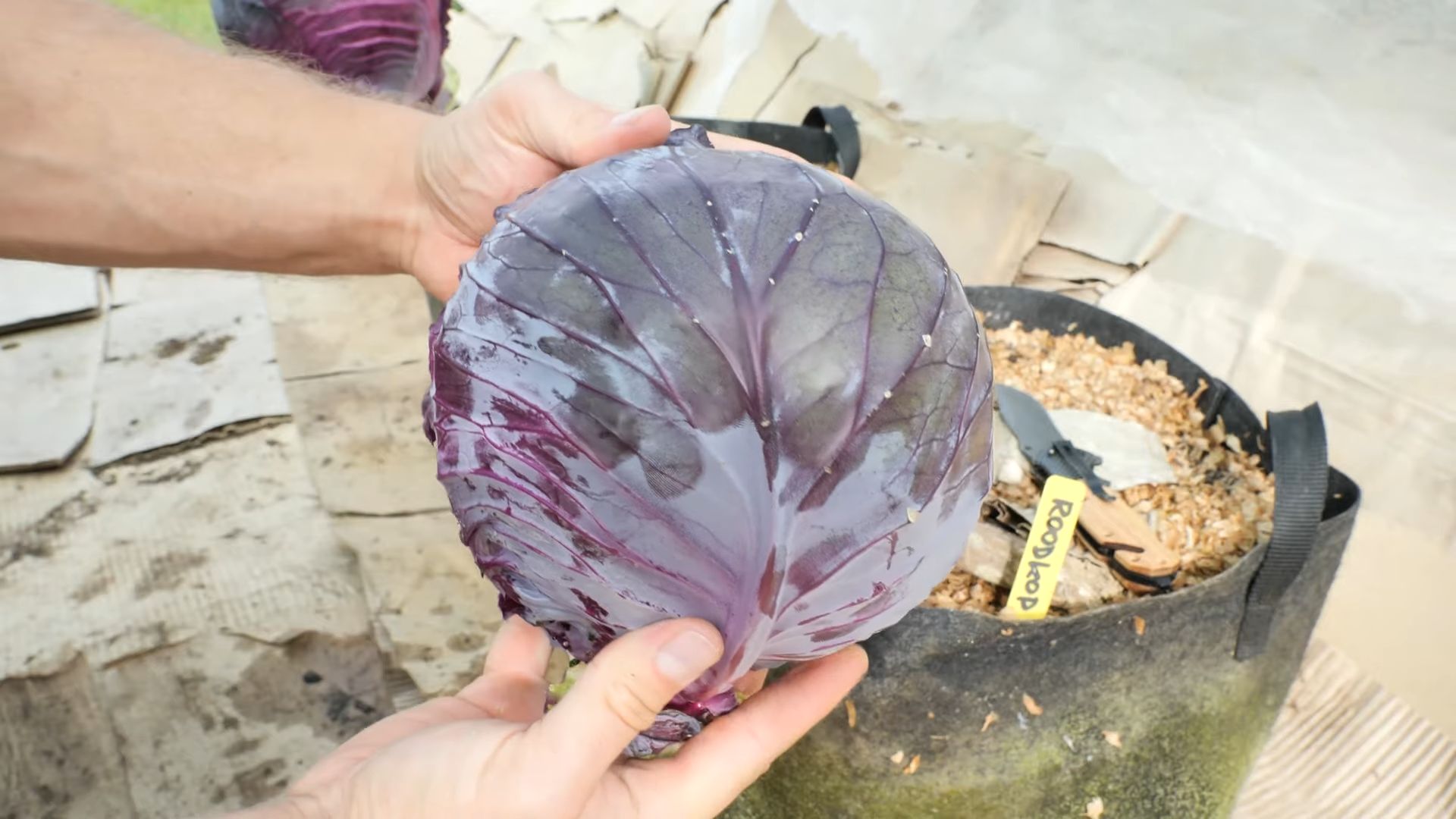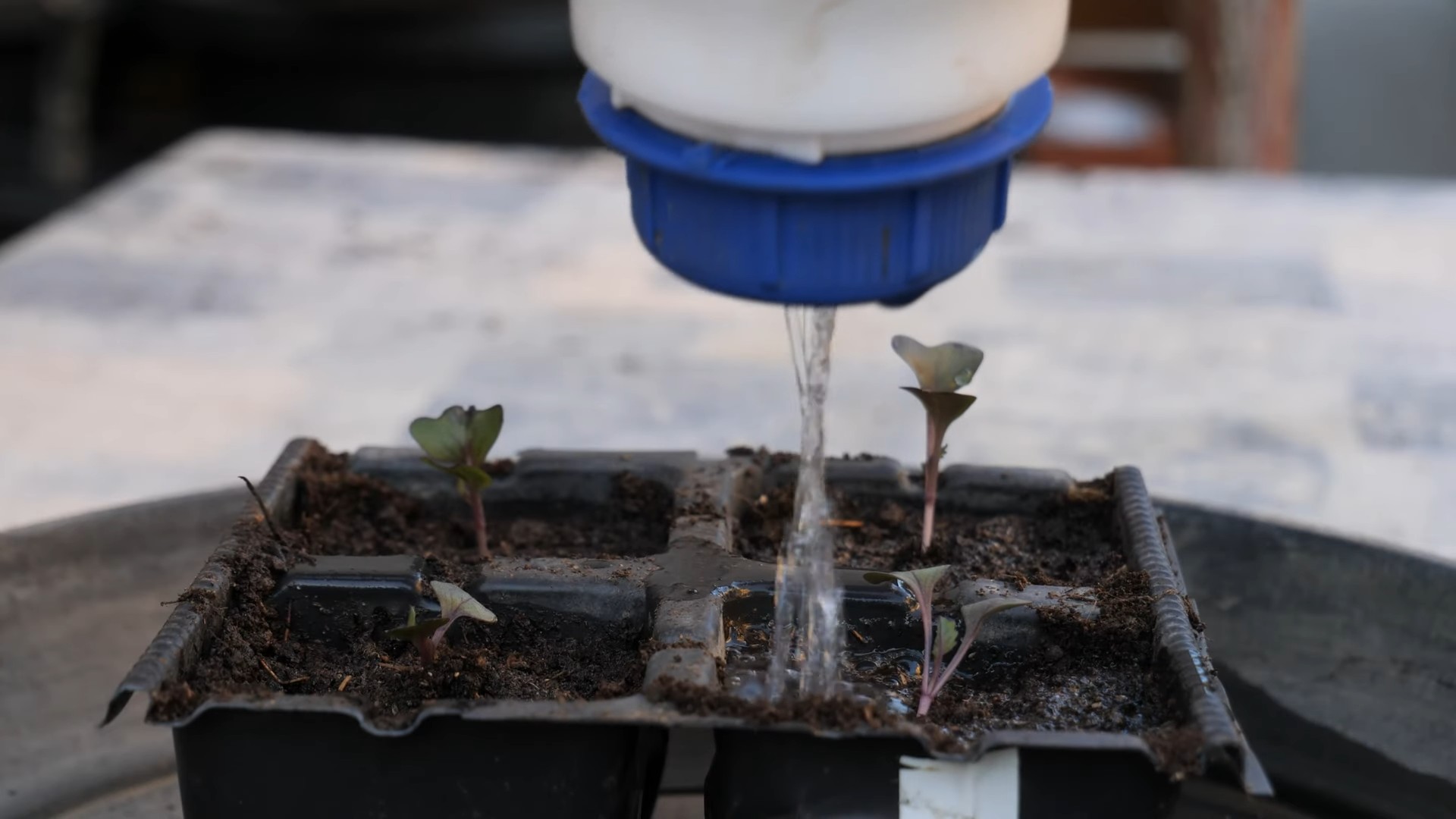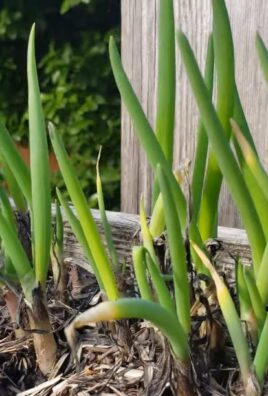Growing Red Cabbage might seem intimidating, but trust me, it’s a rewarding experience that adds a vibrant splash of color and nutrition to your garden and your plate! Have you ever dreamt of harvesting your own jewel-toned heads of cabbage, ready to be transformed into delicious slaws, braised dishes, or even fermented delights? This isn’t just about gardening; it’s about connecting with a tradition that stretches back centuries.
Cabbage, in general, has a rich history, cultivated since ancient times and valued for its hardiness and nutritional benefits. Red cabbage, with its striking color derived from anthocyanins (powerful antioxidants!), brings an extra layer of health benefits to the table. But let’s be honest, sometimes growing your own vegetables can feel overwhelming. That’s where these simple, effective DIY tricks come in.
I’m here to share some easy-to-follow tips and hacks that will help you succeed in growing red cabbage, even if you’re a beginner. We’ll cover everything from soil preparation and seed starting to pest control and harvesting. Imagine the satisfaction of serving a meal featuring red cabbage you nurtured from a tiny seed! So, grab your gardening gloves, and let’s get started on this colorful adventure together. You’ll be amazed at how easy and enjoyable it is to grow your own red cabbage with these simple DIY solutions!

Growing Red Cabbage: A Beginner’s Guide to a Vibrant Harvest
Okay, so you want to grow red cabbage? Awesome! It’s not as intimidating as it looks, and the payoff – a gorgeous, crunchy, and nutritious head of cabbage – is totally worth it. I’ve grown red cabbage for years, and I’m excited to share my tips and tricks with you. Let’s get started!
Choosing the Right Variety
First things first, let’s talk about varieties. Red cabbage isn’t just “red cabbage.” There are different types that mature at different rates and have slightly different flavors. Here are a few popular options:
* ‘Red Acre’: This is a classic, reliable variety that matures relatively quickly (around 75-85 days). It produces medium-sized, round heads with a good, solid texture.
* ‘Ruby Ball’: Another early maturing option (around 70-80 days), ‘Ruby Ball’ is known for its deep red color and slightly sweeter flavor. It’s also a good choice for smaller gardens.
* ‘Red Drumhead’: If you’re looking for larger heads, ‘Red Drumhead’ is a good bet. It takes a bit longer to mature (around 90-100 days), but the heads can get quite substantial.
* ‘Scarlet O’Hara’: This variety is known for its excellent storage capabilities. It matures in about 85-95 days and produces dense, flavorful heads.
I personally love ‘Red Acre’ because it’s so dependable, but feel free to experiment and find the variety that works best for your climate and taste.
Starting Your Cabbage: Seeds or Transplants?
You have two main options for starting your red cabbage: from seed or from transplants. Both have their pros and cons.
* Starting from Seed: This is the more economical option, and it gives you more control over the entire growing process. However, it requires more time and effort, and you’ll need to start the seeds indoors several weeks before the last frost.
* Using Transplants: This is the easier option, especially for beginners. You can buy transplants from a local nursery or garden center. This saves you time and effort, but it can be more expensive.
I usually start my cabbage from seed because I enjoy the process, but if you’re short on time or space, transplants are a great alternative.
Starting from Seed (If You Choose This Route)
Okay, let’s dive into starting red cabbage from seed.
1. Timing is Key: Start your seeds indoors about 6-8 weeks before the last expected frost in your area. This will give them a head start before they go into the garden.
2. Prepare Your Seed Starting Mix: Use a good quality seed starting mix. This is important because it’s sterile and provides the right nutrients for young seedlings. I like to use a mix of peat moss, vermiculite, and perlite.
3. Sow the Seeds: Fill your seed starting trays or pots with the mix and gently press the seeds into the surface, about ¼ inch deep. I usually sow 2-3 seeds per cell to increase my chances of germination.
4. Water Gently: Water the seeds gently using a spray bottle or watering can with a fine rose. You want to keep the soil moist but not waterlogged.
5. Provide Warmth and Light: Place the trays or pots in a warm location (around 70-75°F) and provide plenty of light. A sunny windowsill can work, but I prefer to use grow lights for more consistent results.
6. Thin the Seedlings: Once the seedlings have emerged and have a couple of true leaves (the second set of leaves), thin them out, leaving only the strongest seedling in each cell.
7. Harden Off the Seedlings: About a week before you plan to transplant the seedlings outdoors, you’ll need to harden them off. This means gradually exposing them to outdoor conditions to help them adjust. Start by placing them outside for a few hours each day, gradually increasing the amount of time they spend outdoors.
Preparing the Garden Bed
Whether you’re using seeds or transplants, preparing the garden bed is crucial for success.
1. Choose a Sunny Location: Red cabbage needs at least 6 hours of sunlight per day. Choose a location in your garden that gets plenty of sun.
2. Amend the Soil: Red cabbage prefers well-drained, fertile soil with a pH of 6.0-7.0. Amend the soil with compost or other organic matter to improve drainage and fertility. I like to add a generous amount of compost and some aged manure.
3. Remove Weeds: Clear the area of any weeds. Weeds can compete with your cabbage for nutrients and water.
4. Till or Dig the Soil: Loosen the soil to a depth of at least 12 inches. This will make it easier for the cabbage roots to grow.
Transplanting Your Cabbage
Now for the exciting part – transplanting your cabbage into the garden!
1. Timing is Important: Transplant your cabbage seedlings or transplants outdoors after the last expected frost. The soil temperature should be at least 50°F.
2. Space the Plants Properly: Space the plants about 18-24 inches apart in rows that are 24-36 inches apart. This will give them enough room to grow and mature.
3. Dig the Holes: Dig holes that are slightly larger than the root ball of the seedlings or transplants.
4. Gently Remove the Plants: Carefully remove the seedlings or transplants from their containers. Be gentle to avoid damaging the roots.
5. Place the Plants in the Holes: Place the plants in the holes and backfill with soil. Make sure the top of the root ball is level with the soil surface.
6. Water Thoroughly: Water the plants thoroughly after transplanting. This will help them settle in and establish their roots.
7. Mulch Around the Plants: Apply a layer of mulch around the plants to help retain moisture, suppress weeds, and regulate soil temperature. I like to use straw or wood chips.
Caring for Your Growing Cabbage
Once your cabbage is in the ground, it’s important to provide it with the care it needs to thrive.
1. Water Regularly: Red cabbage needs consistent moisture, especially during hot, dry weather. Water deeply and regularly, aiming for about 1-1.5 inches of water per week.
2. Fertilize Regularly: Red cabbage is a heavy feeder, so it needs regular fertilization. Use a balanced fertilizer (like 10-10-10) every 2-3 weeks. You can also side-dress with compost or aged manure.
3. Control Pests: Cabbage is susceptible to a variety of pests, including cabbage worms, aphids, and flea beetles. Inspect your plants regularly and take action if you see any signs of infestation. I like to use organic pest control methods, such as insecticidal soap or neem oil. You can also cover your plants with row covers to prevent pests from reaching them.
4. Weed Regularly: Keep the area around your cabbage plants free of weeds. Weeds can compete with your cabbage for nutrients and water.
5. Watch for Diseases: Cabbage can also be affected by diseases, such as black rot and clubroot. Choose disease-resistant varieties and practice good sanitation to prevent these problems.
Harvesting Your Red Cabbage
The moment you’ve been waiting for – harvesting your red cabbage!
1. Timing is Key: Red cabbage is ready to harvest when the heads are firm and dense. The exact timing will depend on the variety you’re growing and the weather conditions.
2. Check for Firmness: Gently squeeze the head of the cabbage. If it feels firm and solid, it’s ready to harvest.
3. Cut the Head: Use a sharp knife to cut the head of the cabbage from the stem. Leave a few outer leaves attached to protect the head.
4. Store Properly: Red cabbage can be stored in the refrigerator for several weeks. Wrap the head in plastic wrap or place it in a plastic bag to prevent it from drying out.
Troubleshooting Common Problems
Even with the best care, you might encounter some problems while growing red cabbage. Here are a few common issues and how to address them:
* Cabbage Worms: These green caterpillars can quickly devour your cabbage leaves. Handpick them off the plants or use Bacillus thuringiensis (Bt), a natural insecticide.
* Aphids: These tiny insects suck the sap from your cabbage leaves, causing them to curl and yellow. Spray the plants with insecticidal soap or neem oil.
* Flea Beetles: These small, jumping beetles can create tiny holes in your cabbage leaves. Cover your plants with row covers or use diatomaceous earth.
* Black Rot: This bacterial disease causes dark, sunken

Conclusion
So, there you have it! Growing red cabbage at home, while it might seem daunting at first, is a surprisingly rewarding experience. We’ve walked through the entire process, from selecting the right seeds and preparing your soil to nurturing your seedlings and harvesting your vibrant, homegrown heads. But why should you bother with all this effort when you can simply buy red cabbage at the store?
The answer lies in the unparalleled freshness and flavor you simply can’t replicate with store-bought produce. Imagine the crisp, slightly peppery taste of a red cabbage you’ve nurtured from seed, knowing exactly where it came from and what went into its growth. It’s a taste that bursts with vitality and adds a unique dimension to your salads, slaws, and cooked dishes. Beyond the superior flavor, growing your own red cabbage allows you to control the entire process, ensuring it’s free from harmful pesticides and herbicides. You’re providing your family with healthy, wholesome food while also reducing your carbon footprint.
But the benefits don’t stop there. Gardening is a fantastic way to connect with nature, relieve stress, and get some much-needed exercise. Tending to your red cabbage plants can be a meditative experience, allowing you to slow down, appreciate the beauty of the natural world, and feel a sense of accomplishment as you watch your efforts bear fruit (or, in this case, cabbage!).
Don’t be afraid to experiment! Try different varieties of red cabbage to find your favorite flavor profile. Some varieties are sweeter, while others have a more intense, peppery bite. You can also adjust the soil pH to influence the color of your cabbage, with more acidic soil resulting in a deeper red hue. Consider companion planting with herbs like rosemary or thyme to deter pests and enhance the flavor of your cabbage.
Ready to take the plunge and grow your own red cabbage? We encourage you to give it a try! Even if you only have a small balcony or patio, you can still grow red cabbage in containers. Start small, learn as you go, and don’t be discouraged by setbacks. Gardening is a journey, and every mistake is an opportunity to learn and improve.
And most importantly, we want to hear about your experience! Share your tips, tricks, and triumphs in the comments below. Let us know what varieties you’re growing, what challenges you’ve faced, and what delicious dishes you’ve created with your homegrown red cabbage. Together, we can build a community of passionate gardeners and inspire others to embrace the joy of growing their own food. So, get your hands dirty, plant some seeds, and discover the magic of growing red cabbage!
Frequently Asked Questions (FAQ)
What is the best time of year to plant red cabbage?
The best time to plant red cabbage depends on your climate. In general, red cabbage is a cool-season crop, so it thrives in spring and fall. For a spring harvest, start seeds indoors 6-8 weeks before the last expected frost. Transplant seedlings outdoors 2-3 weeks before the last frost. For a fall harvest, start seeds indoors in mid-summer and transplant seedlings outdoors in late summer or early fall. Check your local frost dates to determine the optimal planting time for your region.
How much sunlight does red cabbage need?
Red cabbage needs at least 6 hours of direct sunlight per day to thrive. Choose a sunny location in your garden or on your balcony for your red cabbage plants. If you live in a particularly hot climate, some afternoon shade can be beneficial to prevent the leaves from scorching.
What kind of soil is best for growing red cabbage?
Red cabbage prefers well-drained, fertile soil that is rich in organic matter. Amend your soil with compost or well-rotted manure before planting to improve its fertility and drainage. The ideal soil pH for red cabbage is between 6.0 and 7.0. You can test your soil pH with a soil testing kit and adjust it accordingly with lime (to raise the pH) or sulfur (to lower the pH).
How often should I water my red cabbage plants?
Red cabbage needs consistent moisture to thrive. Water your plants deeply and regularly, especially during dry periods. Aim to keep the soil consistently moist but not waterlogged. Mulching around your plants can help to retain moisture and suppress weeds.
What are some common pests and diseases that affect red cabbage?
Red cabbage can be susceptible to several pests and diseases, including cabbage worms, aphids, flea beetles, and clubroot. Regularly inspect your plants for signs of pests or diseases. You can control cabbage worms with Bacillus thuringiensis (Bt), a natural insecticide. Aphids can be controlled with insecticidal soap or neem oil. Flea beetles can be deterred with row covers. Clubroot is a soilborne disease that can be prevented by practicing crop rotation and maintaining a healthy soil pH.
How do I harvest red cabbage?
Red cabbage is ready to harvest when the head is firm and solid. The size of the head will vary depending on the variety, but generally, heads are ready to harvest when they are about 6-8 inches in diameter. To harvest, use a sharp knife to cut the head from the stem, leaving a few outer leaves attached.
How do I store red cabbage?
Red cabbage can be stored in the refrigerator for several weeks. Wrap the head in plastic wrap or store it in a plastic bag to prevent it from drying out. You can also store red cabbage in a root cellar or other cool, dark place for several months.
Can I grow red cabbage in containers?
Yes, you can grow red cabbage in containers. Choose a large container that is at least 12 inches in diameter and 12 inches deep. Fill the container with a well-draining potting mix. Be sure to water your container-grown red cabbage regularly, as containers tend to dry out more quickly than garden beds.
How can I influence the color of my red cabbage?
The color of red cabbage is influenced by the soil pH. More acidic soil (lower pH) will result in a deeper red or purple color, while more alkaline soil (higher pH) will result in a more bluish or greenish color. You can adjust the soil pH by adding lime (to raise the pH) or sulfur (to lower the pH).
What are some delicious ways to use homegrown red cabbage?
Homegrown red cabbage is incredibly versatile and can be used in a variety of dishes. It’s delicious in salads, slaws, stir-fries, soups, and stews. You can also roast it, grill it, or pickle it. Red cabbage pairs well with a variety of flavors, including apples, onions, vinegar, and spices. Experiment with different recipes and find your favorite ways to enjoy your homegrown red cabbage!




Leave a Comment